How to Install Deluge BitTorrent Client on Ubuntu 20.04 Desktop/Server
This tutorial will be showing you how to install Deluge on Ubuntu 20.04 desktop and server. Deluge is a free, open-source (GPL3) and lightweight BitTorrent client, available for Linux, FreeBSD, macOS and Windows. It has a rich collection of plugins that you can install to extend its functionality. For example, you can install the streaming plugin so you can stream video or audio directly from Deluge while downloading. The latest stable version, 2.0.3, was released on June 12, 2019.
Install Latest Version of Deluge on Ubuntu 20.04 Desktop from PPA
Ubuntu 20.04 software repository includes Deluge 2.0.3. However, when a newer version comes out, it would take some time for the Ubuntu team to update it. To ensure you get the newest version as soon as possible, you need to install it from the official Deluge PPA. Open up a terminal window, then run the following 3 commands one at a time.
sudo apt install software-properties-common sudo add-apt-repository ppa:deluge-team/stable sudo apt install deluge
This PPA also works on other Linux distributions that are based on Ubuntu such as Linux Mint and Elementary OS. If you already have deluge installed, then the above commands will update your deluge to the latest version. Don’t worry, your existing torrents will be fine.
Once installed, you can start it from the application menu.

Deluge 2.0.3 user interface
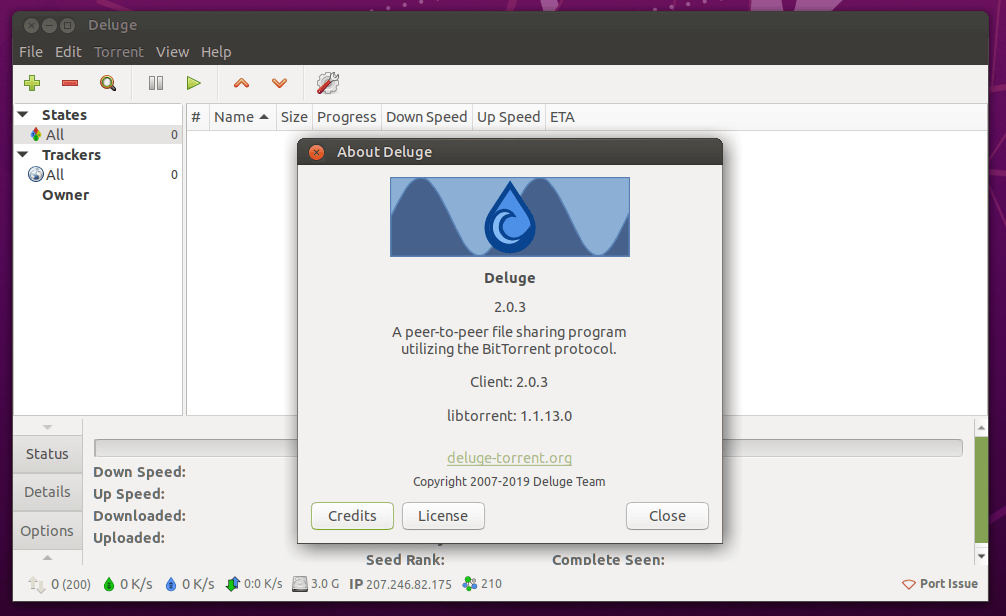
How to Enable Deluge Autostart on Ubuntu 20.04 Desktop
To enable autostart at boot time, open the Startup Applications from your applications menu. Then click Add button to add a new startup program. In the Name field, you can enter something like “Deluge GTK”. In the Command field, enter /usr/bin/python /usr/bin/deluge-gtk. You can leave the comment field blank. Then click Add button.
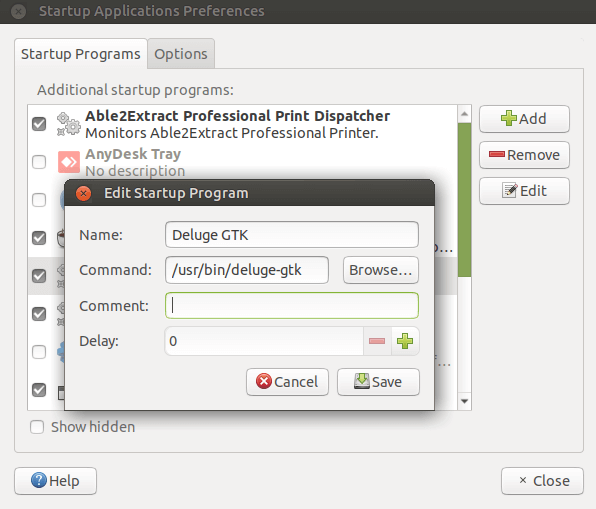
Warning: You need to use a VPN to hide your IP address when downloading torrents, or you may receive copyright infringement complaints from motion picture companies and may face a financial penalty in a worst-case scenario.
Install Deluge BitTorrent on Ubuntu 20.04 Server
You can install Deluge BitTorrent daemon on a server and manage the program via the Deluge web interface (You control it in a web browser). Use the following commands to install Deluge daemon and Deluge Web interface on Ubuntu 20.04 server.
sudo apt install software-properties-common sudo add-apt-repository ppa:deluge-team/stable sudo apt install deluged deluge-web
Then create the deluge user and group so that deluge can run as an unprivileged user, which will increase your server’s security.
sudo adduser --system --group deluge
The --system flag means we are creating a system user instead of normal user. A system user doesn’t have password and can’t login, which is what you would want for Deluge. A home directory /home/deluge/ will be created for this user. You may want to add your user account to the deluge group with the following command so that the user account has access to the files downloaded by Deluge BitTorrent. Files are downloaded to /home/deluge/Downloads by default. Note that you need to re-login for the groups change to take effect.
sudo adduser your-username deluge
Once that’s done, create a systemd service file for deluge with your favourite text editor such as nano.
sudo nano /etc/systemd/system/deluged.service
Copy and paste the following lines into the file. By default, deluged will run as a background daemon. Since we run it as a systemd service, which already runs in the background, so we add the -d (--do-not-daemonize) option to make it run in the foreground.
[Unit] Description=Deluge Bittorrent Client Daemon After=network-online.target [Service] Type=simple User=deluge Group=deluge UMask=007 ExecStart=/usr/bin/deluged -d Restart=on-failure # Configures the time to wait before service is stopped forcefully. TimeoutStopSec=300 [Install] WantedBy=multi-user.target
To save a file in Nano text editor, press Ctrl+O, then press Enter to confirm. To exit, press Ctrl+X. Now restart deluge deamon with the following command.
sudo systemctl restart deluged
You may also want to enable auto-start when Ubuntu 20.04 is booting up.
sudo systemctl enable deluged
Check Deluge status:
systemctl status deluged
You can see that deluged is running and autostart is enabled. If it’s exited or isn’t running, you may need to restart it with sudo systemctl restart deluged.

Accessing Deluge WebUI
To be able to access the deluge WebUI, we also need to create a systemd service file for deluge web.
sudo nano /etc/systemd/system/deluge-web.service
Copy and paste the following text into the file. By default, deluge-web will run as a background daemon. Since we run it as a systemd service, which already runs in the background, so we add the -d (--do-not-daemonize) option to make deluge-web run in the foreground.
[Unit] Description=Deluge Bittorrent Client Web Interface After=network-online.target [Service] Type=simple User=deluge Group=deluge UMask=027 ExecStart=/usr/bin/deluge-web -d Restart=on-failure [Install] WantedBy=multi-user.target
Save and close the file. Then start and enable deluge-web, check its status.
sudo systemctl start deluge-web sudo systemctl enable deluge-web systemctl status deluge-web
Once the deluge-web service is running, it listens on TCP port 8112. Now in your Web browser address bar, type
your-server-ip:8112
You will be asked to enter a password, which by default is deluge, to access the Web UI. (Your firewall might be preventing access to port 8112, so check your firewall setting if you can’t access the web UI).
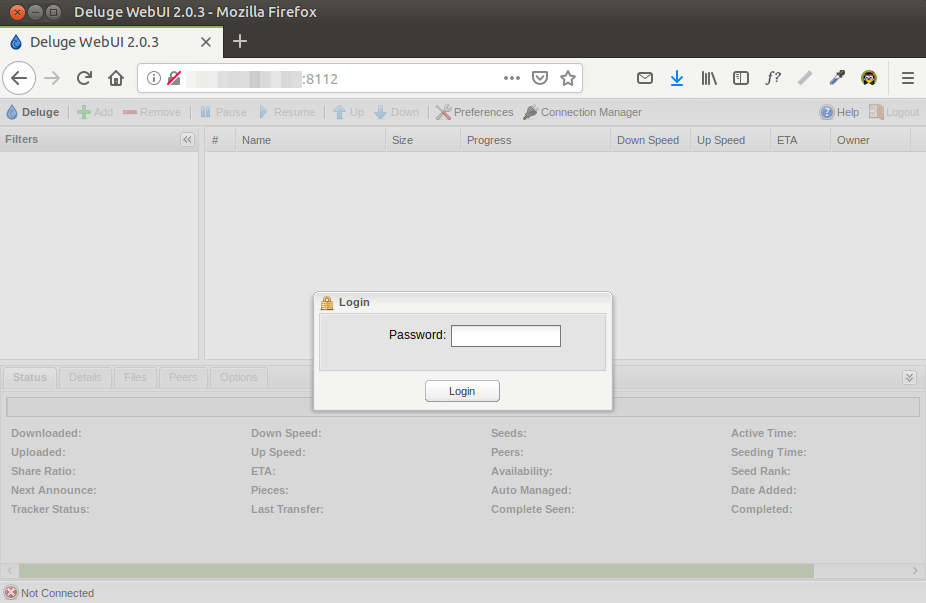
It’s recommended to change the default password. After you choose to change password, the connection manager window will pop up asking you to connect to Deluge daemon which is listening on 127.0.0.1:58846. Select the connection and click Connect button.
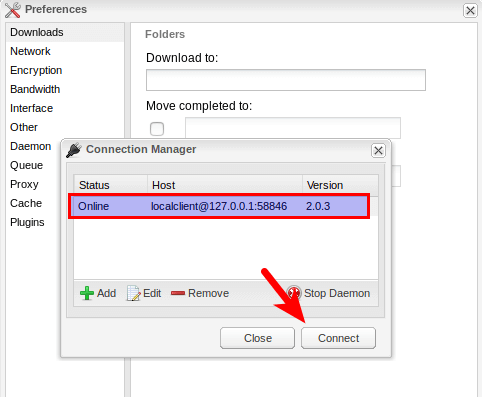
Then you will be able to change the WebUI password.

To add new torrents, click the add button on the upper left corner. You can add a torrent file from your local computer or add magnet link. By default, files are downloaded to /home/deluge/Downloads directory.

Set Up Reverse Proxy for Deluge WebUI
A reverse proxy is a proxy for another server, in this case the Deluge WebUI. You can set up reverse proxy so that you will be able access Deluge WebUI from a domain name and secure HTTPS connection. I will show you how to set up reverse proxy with Nginx and Apache.
Nginx
Nginx is a very popular web server and reverse proxy. If you prefer to use Nginx, run the following command to install it on Ubuntu 20.04.
sudo apt install nginx
Start Nginx
sudo systemctl start nginx
Then create an Nginx server block file for Deluge WebUI.
sudo nano /etc/nginx/conf.d/deluge-webui.conf
Copy and paste the following texts into the file. Replace the red-colored text with your own domain name. You should also set DNS A record for your domain name. If you don’t have a real domain name, I recommend going to NameCheap to buy one. The price is low and they give whois privacy protection free for life.
server {
listen 80;
listen [::]:80;
server_name torrent.yourdomain.com;
access_log /var/log/nginx/deluge-web.access;
error_log /var/log/nginx/deluge-web.error;
location / {
proxy_pass http://127.0.0.1:8112;
}
}
Save and close the file. Then test Nginx configuration.
sudo nginx -t
If the test is successful, reload Nginx
sudo systemctl reload nginx
Now you can access Deluge WebUI via your domain name (torrent.yourdomain.com).
Apache
If you prefer Apache over Nginx, then install Apache web server on Ubuntu 20.04 by using the following command.
sudo apt install apache2
To use Apache as a reverse proxy, we need to enable the proxy modules and the header module.
sudo a2enmod proxy proxy_http headers proxy_wstunnel
Then create a virtual host file for Deluge WebUI.
sudo nano /etc/apache2/sites-available/deluge-webui.conf
Put the following configurations into the file. Replace torrent.yourdomain.com with your actual domain name. Don’t forget to create DNS A record for this sub-domain. If you don’t have a real domain name, I recommend going to NameCheap to buy one. The price is low and they give whois privacy protection free for life.
<VirtualHost *:80>
ServerName torrent.yourdomain.com
ErrorDocument 404 /404.html
#HTTP proxy
ProxyPass / http://localhost:8112/
ProxyPassReverse / http://localhost:8112/
Header always unset X-Frame-Options
</VirtualHost>
Save and close the file. Then enable this virtual host.
sudo a2ensite deluge-webui.conf
Restart Apache
sudo systemctl restart apache2
Now you can access Deluge WebUI via your domain name (torrent.yourdomain.com).
Listening on localhost only
After setting up the reverse proxy, we can configure deluge-web process to listen only on localhost (127.0.0.1), so that it’s not directly exposed to the Internet. To achieve that, we need to edit the systemd service file.
sudo nano /etc/systemd/system/deluge-web.service
Find the following line.
ExecStart=/usr/bin/deluge-web -d
Change it to
ExecStart=/usr/bin/deluge-web -d -i 127.0.0.1
Save and close the file. Then reload systemd daemon.
sudo systemctl daemon-reload
And restart deluge-web service.
sudo systemctl restart deluge-web
You can check the listening status with:
sudo ss -lnpt | grep 8112
Enable HTTPS
To secure the Web UI, you can install a free Let’s Encrypt certificate. First you need to install the Let’s Encrypt client (certbot) on Ubuntu 20.04 server.
sudo apt install certbot
If you use Nginx, then you also need to install the Certbot Nginx plugin.
sudo apt install python3-certbot-nginx
Next, run the following command to automatically obtain and install Let’s Encrypt certificate.
sudo certbot --nginx --agree-tos --redirect --hsts --staple-ocsp --email you@example.com -d torrent.yourdomain.com
If you use Apache, then you need to install the Certbot Apache plugin.
sudo apt install python3-certbot-apache
Next, run the following command to obtain and install TLS certificate.
sudo certbot --apache --agree-tos --redirect --hsts --staple-ocsp --email you@example.com -d torrent.yourdomain.com
Where:
- –nginx: Use the Nginx authenticator and installer
- –apache: Use the Apache authenticator and installer
- –agree-tos: Agree to Let’s Encrypt terms of service
- –redirect: Enforce HTTPS by adding 301 redirect.
- –staple-ocsp: Enable OCSP Stapling.
- –email: Email used for registration and recovery contact.
- -d flag is followed by a list of domain names, separated by comma. You can add up to 100 domain names.
You will be asked if you want to receive emails from EFF(Electronic Frontier Foundation). After choosing Y or N, your TLS certificate will be automatically obtained and configured for you, which is indicated by the message below.
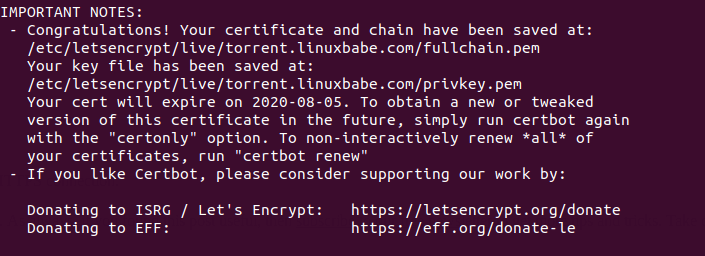
Once that’s done, refresh deluge Web UI. It will be automatically redirected to HTTPS connection.
Having Trouble Obtaining TLS Certificate?
If you see the following error while trying to obtain TLS certificate:
module 'acme.challenges' has no attribute 'TLSSNI01'
You need to edit a config file.
sudo nano /usr/lib/python3/dist-packages/certbot_nginx/configurator.py
Change
return [challenges.HTTP01, challenges.TLSSNI01]
to:
return [challenges.HTTP01]
Save and close the file. Then run the above certbot command again.
Wrapping Up
I hope this tutorial helped you install Deluge on Ubuntu 20.04 desktop or server. As always, if you found this post useful, then subscribe to our free newsletter to get more tips and tricks. Take care.



Awesome tutorial, LB. Don’t particularly need a Torrent client for myself right now but when I do I will remember Deluge and your tutorial.
I have got Deluged working (at least it says it is active (running)) but when I check deluge-web I get this:
m*a:~$ systemctl status deluge-web ● deluge-web.service - Deluge Bittorrent Client Web Interface Loaded: loaded (/etc/systemd/system/deluge-web.service; enabled; vendor preset: enabled) Active: inactive (dead) since Fri 2020-06-26 14:15:58 BST; 45s ago Main PID: 62586 (code=exited, status=0/SUCCESS) Jun 26 14:15:57 s*t deluge-web[62586]: Unable to initialize gettext/locale! Jun 26 14:15:57 s*t deluge-web[62586]: 'ngettext' Jun 26 14:15:57 s*t deluge-web[62586]: Traceback (most recent call last): Jun 26 14:15:57 s*t deluge-web[62586]: File "/usr/lib/python3/dist-packages/deluge/i18n/util.py", line 118, in setup_translation Jun 26 14:15:57 s*t deluge-web[62586]: builtins.__dict__['_n'] = builtins.__dict__['ngettext'] Jun 26 14:15:57 s*t deluge-web[62586]: KeyError: 'ngettext'Here is my Deluge Web Service:
I have tried with and without a ‘-d’ on the ‘ExecStart=/usr/bin/deluge-web’ line
I got it working. I removed deluge-web ran sudo apt install software-properties-common then started again.
Get guide.
One more question can I use LetsEncrypt on a domain like ‘yourdomain.ddns.net’?
Hey Andrew just wondering if you did anything else to get it working. I’m getting the same error regarding ngettext so followed your lead, removed deluge-web and then ran sudo apt install software-properties-common, then apt install deluge-web and started it up, but still get the same error. Was there anything else that you did to get rid of that?
I am sorry David, I do not remember doing anything else.
Thanks anyway Andrew. FWIW and in case it might be of interest to anyone else, I was able to fix by manually editing /usr/lib/python3/dist-packages/deluge/i18n/util.py by adding brackets around ‘ngettext’ in line 117 – see https://dev.deluge-torrent.org/changeset/d6c96d629183e8bab.
I imagine it will get overwritten by updates, but hopefully by then the patch will have worked its way into the update.
I don’t use ddns.net, but in theory, as long as your web browser can load a web page from “yourdomain.ddns.net”, you can use certbot to obtain a free Let’s Encrypt certificate.
Hello Xiao,
I have a diffrent subnet for my VM in UNRAID running Ubuntu, what should i do to make it work?
Andre
I followed this guide however I can’t connect to the Deluge server from another system on the network using deluge to sign in with the user I created in auth and I also enabled it under core.conf
However I can access the WebUI still from the other machine.
I got this when I ran systemctl status deluged and it turned out that I hadn’t actually installed deluged! I had run apt-get install deluge, but I needed to also run apt-get install deluged
systemd[1]: deluged.service: Service hold-off time over, scheduling restart.
systemd[1]: Stopped Deluge Bittorrent Client Daemon.
systemd[1]: deluged.service: Start request repeated too quickly.
systemd[1]: Failed to start Deluge Bittorrent Client Daemon.
systemd[1]: deluged.service: Unit entered failed state.
systemd[1]: deluged.service: Failed with result ‘start-limit’.
sudo apt install deluge
Receiving error wwhile running above command –
E: dpkg was interrupted, you must manually run ‘sudo dpkg –configure -a’ to correct the problem.
It’s because a previous
apt installcommand was interrupted on your system. You need to runsudo dpkg –configure -ato finish the previousapt installcommand.Then install Deluge.
Thanks, for this really fantastic write-up!
Thank you very much, I’m new with Ubuntu (20.04) and finally I’ve been able to get it working perfectly on my VPS, very easy to understand!!!
By the way, is it very different to do it but with rtorrent? I have tried many guides but I can’t always understand them 100%.
Hello,
First of all, thank you very much for all your tutorials.
I build a home server which run almost perfectly.
Your tutorial are very good explain.
I have problem with torrent software, I also tried Transmission without any succes. I think that there is probably a problem with IPTABLES/UFW.
I followed your tutorial for Wireguard, LAMP, Nextcloud, Plex
Could you help me to solve my problem?
Thanks in advance
Thierry
hi, Thanks for the walk through – it was really helpful. I’ve ran into one problem though in that once I’ve set for local listening only I can still access my domain name from an outside connection. Simple test was to try from my phone and I can access the website so not sure what’s gone wrong. I used the apache route for access.
The output of running ‘ sudo ss -lnpt | grep 8112 ‘ is below. I’m not sure whether what its showing is correct or how to troubleshoot it.
LISTEN 0 50 127.0.0.1:8112 0.0.0.0:* users:((“deluge-web”,pid=728,fd=7))
Thanks for any help.
hi i forgot password of deluge-web. How can i reset it?
I have set up deluge follwoing this guide but would like to change the default download driectory. However if I change it I get a permission denied when trying to download a file. I’ve tried chaning local permission, folder ownership, deluge/deluged config files. Nothing seems to work, what am I doing wrong?
HELP! I ran the first two commands without a problem but when I run sudo apt install deluge I get the following error: